Cash Fed Cattle Markets Drop a Few Dollars in Wisconsin
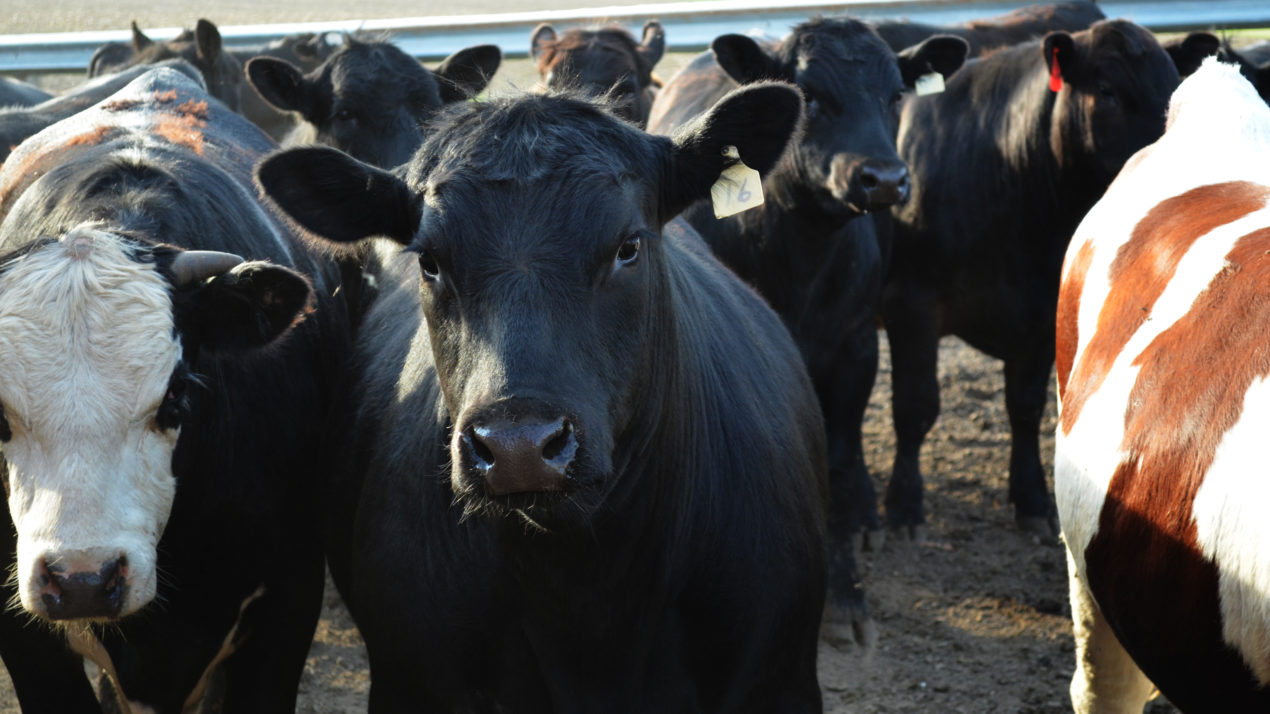
Prepared and written by Jeff Swenson. The Market Update draws information from several sources, including trade publications, radio broadcasts, agricultural news services, individuals involved in the industry as well as USDA NASS and AMS reports. Contact Jeff at [email protected]
The cash fed cattle market was $2.00 to $4.00 lower this week at Wisconsin and surrounding state auction markets. The latest Cattle On Feed report released Friday, October 23 was bearish with on feed numbers 104 percent when compared to October 1, 2019. That was higher than the average trade estimate of 103.3 percent. The largest divergence from estimates came from cattle placed into feedlots during September. While trade expected placements at 102.5 percent compared to a year ago, the report put placements at 106 percent. One bright spot was cattle marketed at 106 percent, and while that’s a friendly number, it was anticipated since average trade estimates came in at 105.9 percent. Carcass weights aren’t coming down, with the average for a beef breed steer at 901 pounds for the second week in a row. Latest export sales for beef were reported at 23,500 metric tons with 18,900 metric tons for 2020 delivery and 4600 metric tons to be delivered next year. While China purchased less pork than expected this week, they were the lead buyer of beef, purchasing 4,300 metric tons. Other buyers included Japan (4,200MT), South Korea (4,200 MT), and Mexico (2,200 MT.) Concern regarding foreign meat demand amid rising COVID-19 cases around the globe is tempering optimism in the beef complex.
Hog prices and pork cutout values have taken a break from their charge higher. There are indications this could be a temporary setback, but of course nothing is a given this year. The latest USDA Cold Storage report released Friday, October 23, showed pork in storage 22 percent below year ago levels. The supply of loins and hams heading into the last two months of the year won’t be short, necessarily, but some analysts are saying they will be tight. Hog supplies are growing, but not to the extent we would expect when compared against the backlog estimates that have been floating around since April. Pork demand domestically remains good – US shoppers are finding the pork in grocery store meat cases. Weekly export totals per the latest USDA report showed 36,000 metric tons of US raised pork sold to foreign buyers. While China was a buyer, their purchases have been disappointing, especially considering the hopes they would purchase more during their ban on German raised pork. Mexico was the largest purchaser at 8,400 metric tons. Japan (6,400 MT), South Korea (2,900 MT,) and China (2,500MT.) rounded out the lead buyers this week.
Producers were in the black according to last week’s Sterling Profit Tracker. Cattle feeding margins were $41.00 per head, but that’s down $95.00 from the previous week. Swine farrow-to-finish operators saw average close-outs $20.00 per head in the black last week, even with the previous week and $2.00 per head lower than a month ago. There’s no doubt this week’s lower cattle and hog prices will further erode break evens. Higher than anticipated corn and soybean prices will impact margins in the future as well.
Beef prices have been coming down at retail outlets and are now below last year on some cuts. Beef loin cuts (steaks) have come under pressure now that summer grilling season is over and restaurant demand for high-end cuts is still slow. Consumers can find Prime loin cuts at chain grocery stores as packers and distributors work to keep product moving. Retail prices for pork is on a mostly steady trend when it comes to retail prices, and it can still be said pork is competing well with other proteins among price conscious shoppers. Chicken breast prices are higher than this time last year with legs and thigh prices dipping lower. Lamb prices remain higher than a year ago at retail. #
High yielding Choice beef breed steers and heifers at Wisconsin and surrounding state auction markets were $2.00 to $4.00/cwt lower, bringing $99.00 to $104.00/cwt. High-yielding cattle with an overnight stand were topping the market at $106.00/cwt. Holstein steers were steady to $2.00/cwt lower at $92.00 to $96.00/cwt. There were reports later in the week of some selling to $100.00/cwt. Cows were steady to lower at 42.00 to $57.00/cwt. Blemish free cows in fleshier condition were selling in the $70.00s and $80.00s/cwt. Dairy breed bull calves were mostly steady to higher at $75.0.00 to $190.00/head. Market lambs were higher, bringing up to $180.00/cwt. Lighter weight lambs brought up to $220.00/cwt.
American Butter Institute Names AMPI’s Reece President

Marshall Reece, Senior Vice President of Sales & Marketing for Associated Milk Producers Inc. of New Ulm, MN, has been named the new president of the American Butter Institute, gaining the position during the organization’s annual meeting, held this year virtually. Other new officers include Catherine Fox, Vice President, Brand & Product Marketing/Dairy Foods for Land O’ Lakes, Inc., of Arden Hills, MN, who became First Vice President; and Mark Armon, Portfolio Leader, Dairy Fat for Darigold based in Seattle. Officers serve for two years, with terms expiring in 2022.
“We are excited to have Marshall lead the organization for the next two years,” said Tom Balmer, executive director of the Arlington, VA-based institute. “His deep knowledge of the butter business and experience on our leadership team have positioned him well to guide ABI in achieving both near term objectives and longer-term aspirations. Marshall’s enthusiasm for the industry is unmatched, and the entire ABI membership stands to benefit.”
In addition, outgoing President Craig Alexander, Vice President, Dairy Ingredients & Regulatory Affairs, O-AT-KA Milk Products of Batavia, NY, was recognized for his service.
The American Butter Institute:
- Promotes and protects the interests and welfare of the butter industry;
- Acts as a clearinghouse for the exchange of ideas beneficial to the butter industry and the consuming public;
- Keeps its members informed of legislative and regulatory proposals; and
- Acts as the voice for all actions affecting the industry and other relevant research and other industry developments and public relation on other interactions with government agencies.
Reece was elected by the 28-member Board of Directors for the organization as part of the conference, which took place Oct. 2. Attendees discussed market trends in the COVID-19 era and received policy updates from ABI staff.
This Week’s Dairy Signal Speakers Announced
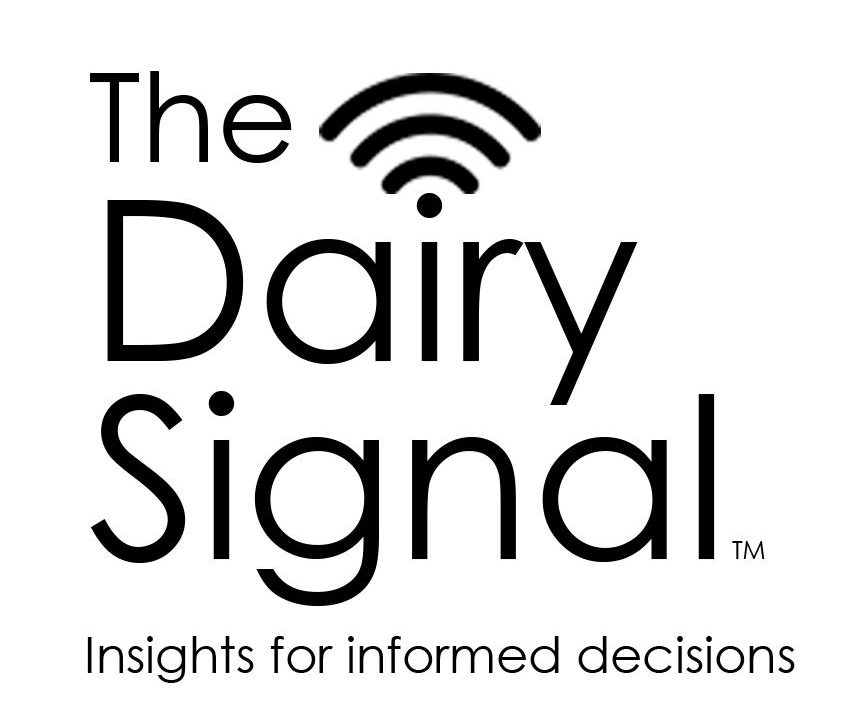
According to Professional Dairy Producers® (PDPW), the line-up of speakers for week 31 of The Dairy Signal™ will highlight two producer panels. An on-farm diversification panel will feature Lolly Lesher, owner/partner in Way-Har Farms, LLC and Way-Har Farm Market, LLC in Bernville, Pennsylvania and Kara Kasten-Olson, owner of Little Farmer Meats and Ag Program Supervisor at the Wisconsin Department of Agriculture, Trade and Consumer Protection. The second panel will feature Ken Feltz, owner, along with his family, of Feltz Family Farms, Inc., and Feltz’s Dairy Store Inc., and Marty Hallock, Mar-Bec Dairy, as they share their experiences of transitioning the family businesses.
Returning to The Dairy Signal is Dr. Nigel Cook, DVM, Professor in Food Animal Production Medicine at UW-Madison, School of Veterinary Medicine and Chair of the Department of Medical Sciences.
Developed by fellow dairy farmers from the PDPW Board of Directors, The Dairy Signal is a weekly series of free educational episodes offering insights and resources for fellow dairy farmers and other food system professionals throughout the value chain. The episodes air live from 12:00-1:00 PM CT each Tuesday, Wednesday, and Thursday; recorded sessions are available later in the day.
On Tuesday’ Dairy Signal, Jessica Mlsna, Energy Advisor with Focus on Energy, explained that an energy assessment is a high-level evaluation by Focus on Energy to help identify areas of opportunity for improved energy efficiency on an operation. She shared how an energy assessment can be beneficial by helping to pinpoint the most cost-effective areas to spend money, verifying a vendor’s claim of energy savings, accessing information about available utility incentives and discussing the viability of future projects when considering expansion. For more information call 888-623-2146 or visit: www.focusonenergy.com.
On Wednesday’s episode, Chris Schlechta, Safety and Loss Control Manager for the Rural Mutual Insurance Company and Michael Immel, Licensed Insurance Agent with the Rural Mutual Insurance Company and Farm Bureau Financial Services and Owner of Immel Insurance & Financial Services talked about the importance of safety inspections and insuring risk areas. Both Schlechta and Immel suggested reaching out to your insurance agent and building a relationship with them. Take time to offer them a farm tour and create a list of questions to discuss with them to help ensure a proper insurance coverage plan is developed.
In his market update on Thursday’s Dairy Signal, Dan Basse, Economist and President of AgResource Company, said dairy cow numbers are increasing as markets remain volatile. Managing margins are difficult due to the uncertainty in several areas including government aid, the continuation of the Farmers for Family food box program, and the election outcome. Producers should take this opportunity to secure corn and soybean needs heading into the spring. He also mentioned the Class III milk price has been reasonably strong, back to $22 per hundredweight, as cheese prices continue to rise.
Dicamba to Remain Weed Control Option
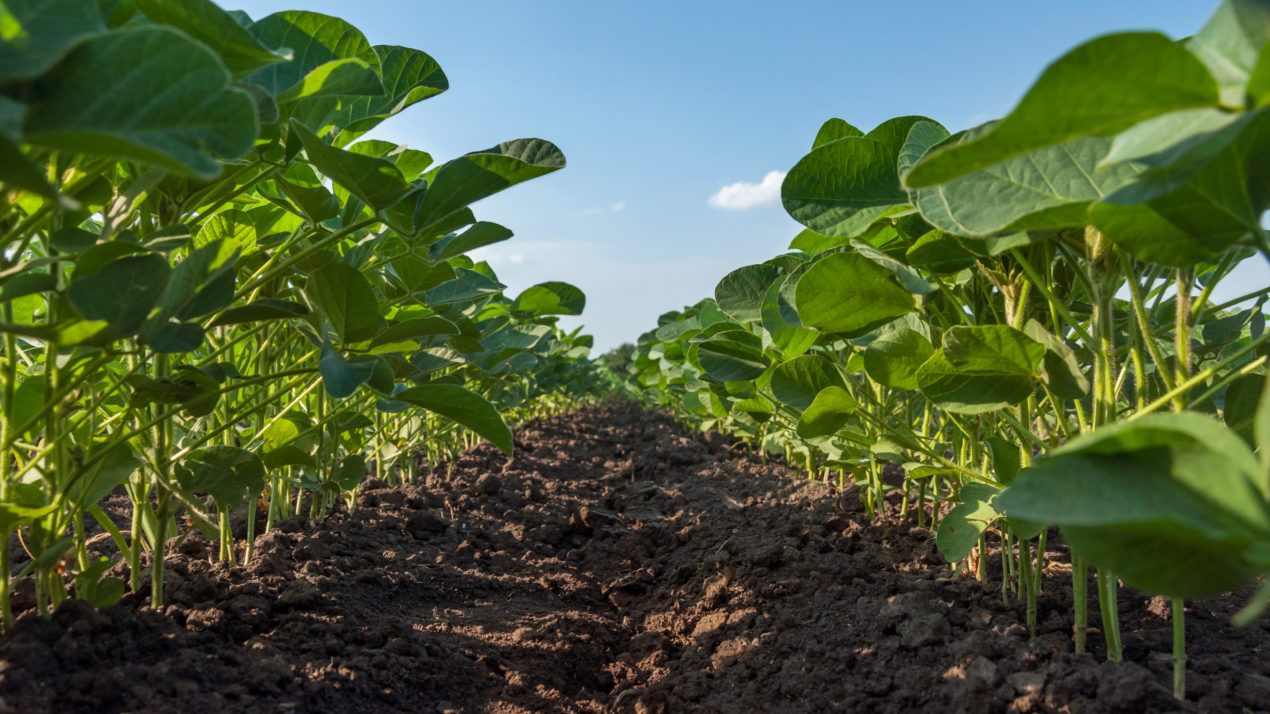
The American Soybean Association (ASA) appreciates that the Environmental Protection Agency (EPA) has announced it will reregister dicamba for 2021 and future use. The product is one of many tools integral to the success of soy growers who face different crop production challenges throughout a diverse growing region spanning 30-plus states.
In response, Rodrigo Werle, Assistant Professor and Extension Cropping Systems Weed Scientist and Shawn Conley, Professor and State Extension Soybean and Small Grain Specialist have released the following statement.
“We believe that having access to dicamba for use POST-emergence on Xtend/Xtendflex soybeans is good news to farmers in Wisconsin struggling to control waterhemp and other troublesome broadleaf weeds such as marestail and giant ragweed. Resistance to Group 9 (glyphosate) and Group 2 (imazethapyr, chlorimuron-ethyl, cloransulam-methyl, etc.) herbicides is widespread in Wisconsin waterhemp populations while resistance to Group 14 (lactofen, fomesafen, fluthiacet-methyl, etc.) is on the rise (see: “Wisconsin Waterhemp Resistance Project – 2019 Update”). Given waterhemp resistance to herbicide Groups 2, 9 and 14, POST-emergence options on soybeans become very limited and farmers struggling with this weed are left to decide between the novel herbicide tolerance trait packages available in the market: dicamba (Xtend soybeans), 2,4-D (Enlist E3 soybeans), or glufosinate (XtendFlex, Enlist E3 and LLGT27 soybeans). Removing dicamba (Group 4) would reduce the effective POST-emergence options and could lead to overreliance on glufosinate (Group 10) and/or 2,4-D (Group 4), which could result in rapid evolution of resistance to such herbicides.
When using dicamba, besides following all label recommendations, farmers should avoid spraying when high temperature and lack of consistent wind are predicted during and 48 hours following a potential application; our research indicates such conditions are conducive to secondary dicamba off-site movement. For additional information see our recent blog post: “Spray solution pH and soybean injury as influenced by dicamba and 2,4-D herbicide formulation and spray additives”. It’s also important that farmers communicate with their neighbors to fully understand their surroundings (such as presence of dicamba sensitive areas, including non-Xtend soybeans). Have a solid plan in terms of who will be responsible for the application (farmer him/herself or commercial applicator) and how will weeds be managed in the buffer areas within their fields before deciding to adopt this technology. It is also likely this is not the end of this story so we encourage farmers to have a plan B (and C) just in case they can’t use dicamba.”
Read their full remarks here.
New Program Links Conservation Award Recipients with Underserved Farmers & Ranchers
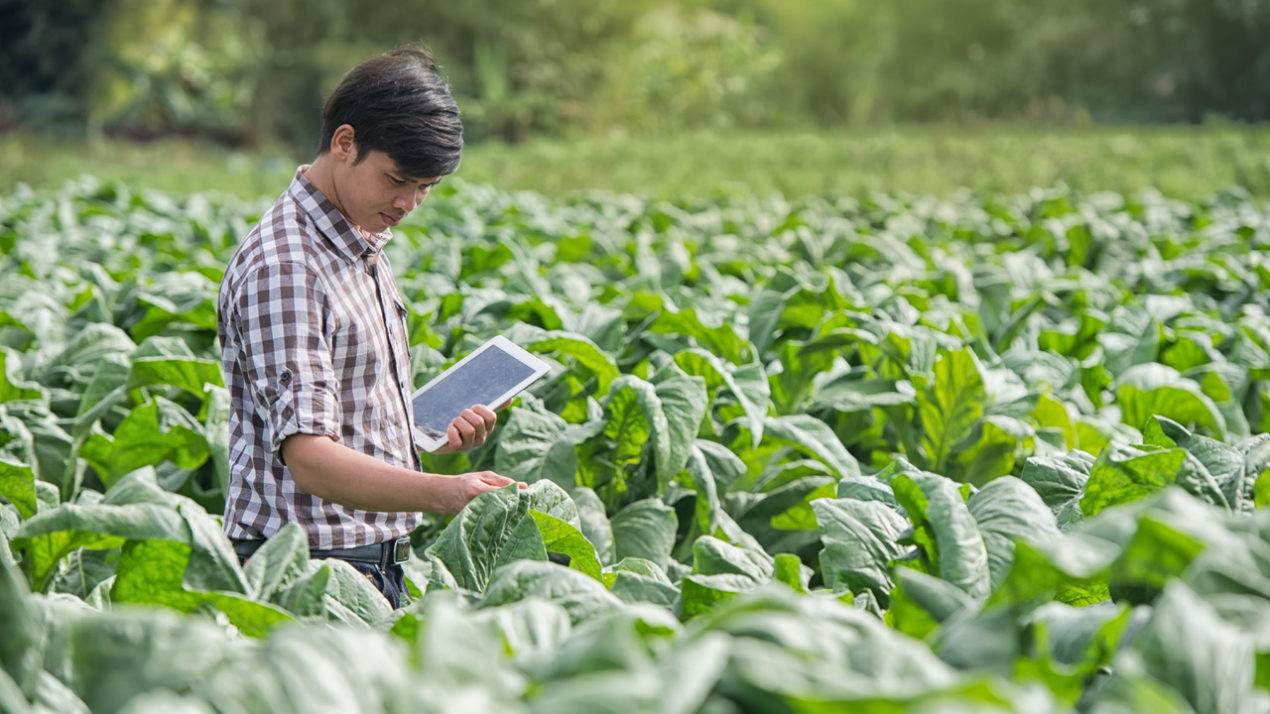
Award-winning, conservation-minded landowners will soon be sharing their knowledge by serving as mentors for historically underserved farmers and ranchers.
Since 2003, the Sand County Foundation’s Leopold Conservation Award has recognized nearly 150 farmers, ranchers and forestland owners nationwide for their efforts to improve soil health, water quality and wildlife habitat.
A $250,000 Conservation Collaboration Grant from the U.S. Department of Agriculture’s Natural Resources Conservation Service (NRCS) will fund Sand County Foundation’s two-year pilot project to promote conservation outreach by its award recipients.
“Leopold Conservation Award recipients are ambassadors who regularly discuss the importance of agricultural conservation with their peers and the general public. This project will empower our network of award recipients to share a range of knowledge, from how to apply for an NRCS conservation program to technical assistance, with an important audience,” said Dr. Heidi Peterson, Sand County Foundation’s Vice President of Agricultural Research and Conservation.
“Research shows that awareness of conservation programs is one of three key challenges for historically underserved producers, along with access to land for expansion and available credit,” Peterson said. “Networking and knowledge-sharing about conservation practices is a significant predictor of conservation practice adoption.”
“While there is no need to create new programs, there is a need to transfer program knowledge to others. Sand County Foundation’s method is a great way to transfer this knowledge to underserved groups,” said Denise Coleman, Pennsylvania State Conservationist for the USDA NRCS.
“Historically underserved farmers and ranchers face many challenges. Knowing someone to ask about a conservation practice can build confidence and have a lasting impact,” said Dick Cates, a Wisconsin farmer who received the Leopold Conservation Award in 2013. “I look forward to participating as a mentor.”
“We all benefit when farmers and ranchers discuss how their farms impact soil health and water quality. We are optimistic this important work will continue beyond its two-year pilot phase,” said Kevin McAleese, Sand County Foundation’s President and Chief Executive Officer.
The project’s title, “Empowering Landowners by Advancing a Land Ethic,” is a nod to renowned conservationist Aldo Leopold. In his influential 1949 book, A Sand County Almanac, Leopold called for an ethical relationship between people and the land. He inspired landowners to adopt what he called “a land ethic”: a moral responsibility to treat land, water and wildlife with respect.
Sand County Foundation is a national non-profit that works at the intersection of agriculture and environmental improvement. For more than 50 years, Sand County Foundation has evaluated and demonstrated conservation practices with farmers, ranchers, foresters and businesses. These efforts produce clean water, healthy soil, abundant wildlife habitat and opportunities for outdoor recreation.
For more information about sponsoring or participating in the program, contact Dr. Heidi Peterson at [email protected].
For more information about the Leopold Conservation Award, contact Lance Irving at [email protected].
Wisconsin Hunters Had a Great 2020 Bear Season
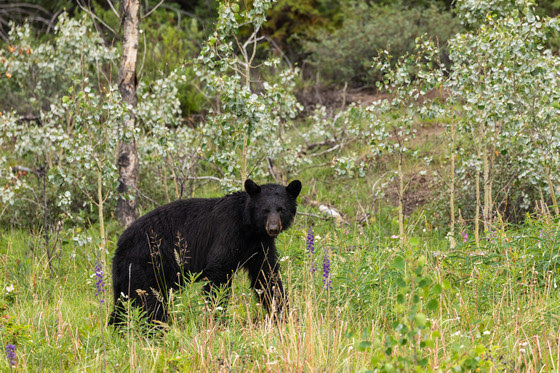
Preliminary data from the Wisconsin Department of Natural Resources (DNR) shows hunters harvested 4,129 bears during the 2020 Wisconsin black bear season, an increase from the 3,679 reported in 2019.
“Wisconsin is a national leader in bear hunting, and preliminary registration data shows that to be true once again this year,” said Randy Johnson, DNR large carnivore specialist. “Despite slight reductions in the overall quota and total permits available to hunters, we saw harvest increase by about 450 bears from the previous year. Once again, the data from harvested bears provided by hunters will be critical to tracking bear population trends and establishing future harvest quotas to achieve population management objectives.”
This year, all four management zones met and exceeded harvest goals, driven primarily by above-average hunter success rates, especially across the three northern zones (A, B, D). With the exception of Zone A (north-central) where a reduction in permits led to a decrease in harvest (from 946 to 892), all zones saw increased harvest from the previous year (Zone B: from 658 to 753; Zone C: from 900 to 1046; Zone D: from 1,175 to 1,438). The data from this year’s harvest will play an important role in determining future harvest levels and ensuring that Wisconsin’s bear population remains healthy and sustainable into the future.
“The first week of the bear season in early September saw below-average temperatures, rain and even a couple of hard frosts across much of the northern part of the state,” Johnson said. “This weather can be generally favorable for bear hunting, particularly for hunting with the use of bait, and likely contributed to the high success rates for those hunters at the beginning of the season. The second week was mostly dry with moderate temperatures, which can be more favorable for those hunting with hounds. In addition, as a result of the pandemic, folks may have had more time to devote to hunting bear this year than in other years. These factors, combined with a healthy bear population, likely all contributed to the high success rates this year.”
Zone-specific preliminary registration information is as follows:
| Zone | Preliminary Harvest | % of Quota Harvested | Hunter Success Rate |
| A | 892 | 112% | 64% |
| B | 753 | 101% | 69% |
| C | 1046 | 116% | 16% |
| D | 1438 | 120% | 63% |
Reflecting continued high interest in Wisconsin’s bear hunting opportunities, more than 119,000 hunters applied for either a harvest permit or preference point for the 2020 season.
Hunters wishing to obtain a permit or preference points for the 2021 season are encouraged to apply through GoWild before the Dec. 10 deadline. New zones will be in effect for the 2021 season, and hunters should make sure to check the new zone map before selecting their zone in GoWild.
“What’s not captured in harvest information are the countless memories made among families and friends and all the hours spent outside taking in Wisconsin’s wonderful outdoors,” Johnson said. “The bear hunting tradition in Wisconsin is very strong, and interest in the activity continues to grow.”
Visit the DNR website to learn more about black bear ecology, history and management in Wisconsin and to review the 2019-29 Wisconsin Black Bear Management Plan.
The Wisconsin DNR searches for waste trends and solutions in landfills
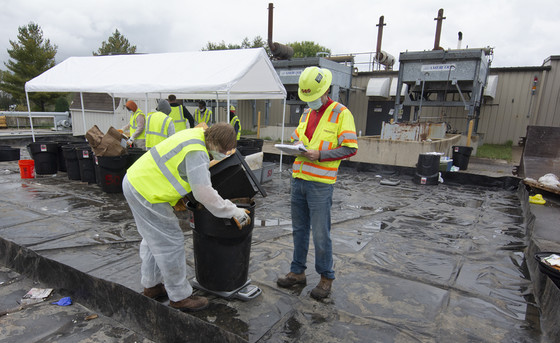
Samples are weighed before heading to the sorting table. Photo credit: Wisconsin DNR
Turning trash into invaluable information, the Wisconsin DNR launched a waste characterization study at Wisconsin landfills.
This past September, SCS Engineers began collecting and sorting samples of municipal solid waste at landfills across the state as part of a study aimed at better understanding what Wisconsinites are throwing in the trash.
The results of the study will provide a powerful planning tool for waste reduction and minimization efforts across the state, and when compared to prior studies conducted in 2003 and 2009, will help officials identify trends in waste and recycling. The study will be released publically to benefit communities and possibly businesses that are considering investing in new equipment or building a new facility that can divert waste into a profit.
“Millions of pounds of materials are diverted through recycling, e-cycling, or composting every year, which keeps hazardous materials out of the environment, saves valuable landfill space, and supports Wisconsin’s economy,” said Kate Strom Hiorns, DNR recycling, and solid waste section chief. “But more can be done. This study will help determine the communication, infrastructure, and resources still needed.”
Crews will visit 12 landfills across the state to sort 400 municipal solid waste samples and visually characterize 640 construction and demolition waste loads. Crews are trained to identify 85 material types, representing eight waste categories including plastics, organics, and hazardous materials. The region, hauler type, and the source of the waste will also be recorded.
“The DNR is looking for opportunities to minimize and divert waste statewide, but also at the source or regional level,” said Casey Lamensky, DNR solid waste coordinator. “The DNR will continue to work with local governments, businesses, and organizations to ensure they have the resources they need to divert materials from the landfill.”
Waste characterization data from 2003 and 2009 provided crucial information for waste management decisions still affecting residents today. Dane County used the 2009 study, which identified construction and demolition materials as one of the top contributing material groups, to properly size a construction and demolition recycling facility at the Rodefeld Landfill.
“We hope the 2020 data will be similarly used,” Lamensky said. “Dane County is a great example of why this information is important.”
A noticeable trend now is new food packaging that not recyclable in the current system as containers shift from steel cans to multi-layer lined packages. She also noted that food waste increased between the 2003 and 2009 studies.
“This will help us get information on what we can do to help decrease the number of organics going to the landfill similar to what we did to help decrease the demolition materials,” Lamensky said. “Organics are incredibly impactful to the environment.”
In the 2009 study, 17 percent of household waste was food waste. As Lamensky explained, the food goes through production, transportation, packing, transportation, storage, and then transportation again, utilizing several resources to end up in a landfill. Additionally, when it is put in the landfill, organic waste is compacted down to the point where oxygen is removed.
“That means organic materials degrade anaerobically, or with different microbes that do not need oxygen,” she said. “The release of that is methane, which is a greenhouse gas that is 26 to 28 times more powerful than CO2. If you look at the world’s food waste just as a greenhouse gas generator, it would actually be the third-largest after the U.S. and China.”
There are some contained systems that can capture the methane and use it productively as energy or eat, and there are requirements that landfills try to collect the methane, but it can be a very expensive and labor-intensive process. The 2020 study will break down specific data on food waste to show what was edible and could have been donated and what were inedible products such as peels or eggshells.
The final report will be published this spring. From mid-October through mid-December, crews will be sampling at landfills located in Appleton, Wisconsin Rapids, Weyerhaeuser, Watertown, Muskego, Franklin, Menomonee Falls, and Eau Claire.
“I think the biggest point for the general public is just an awareness of waste,” Lamensky said. “It is so easy to put something in the garbage and then it is out of sight and out of mind because our system is very effectively managed. However, waste streams change.”
One of those key changes was the huge increase in cardboard packaging, disposable masks, and gloves because of the pandemic.
“Those need to be managed properly,” she said. “Try to think of waste as something you continue to learn about because it is something we all have to deal with.”
Those interested in learning more about recycling in Wisconsin can visit the DNR’s what to recycle page.
Wisconsin Rural Opportunities Foundation Supports Rural Summer Science Camo
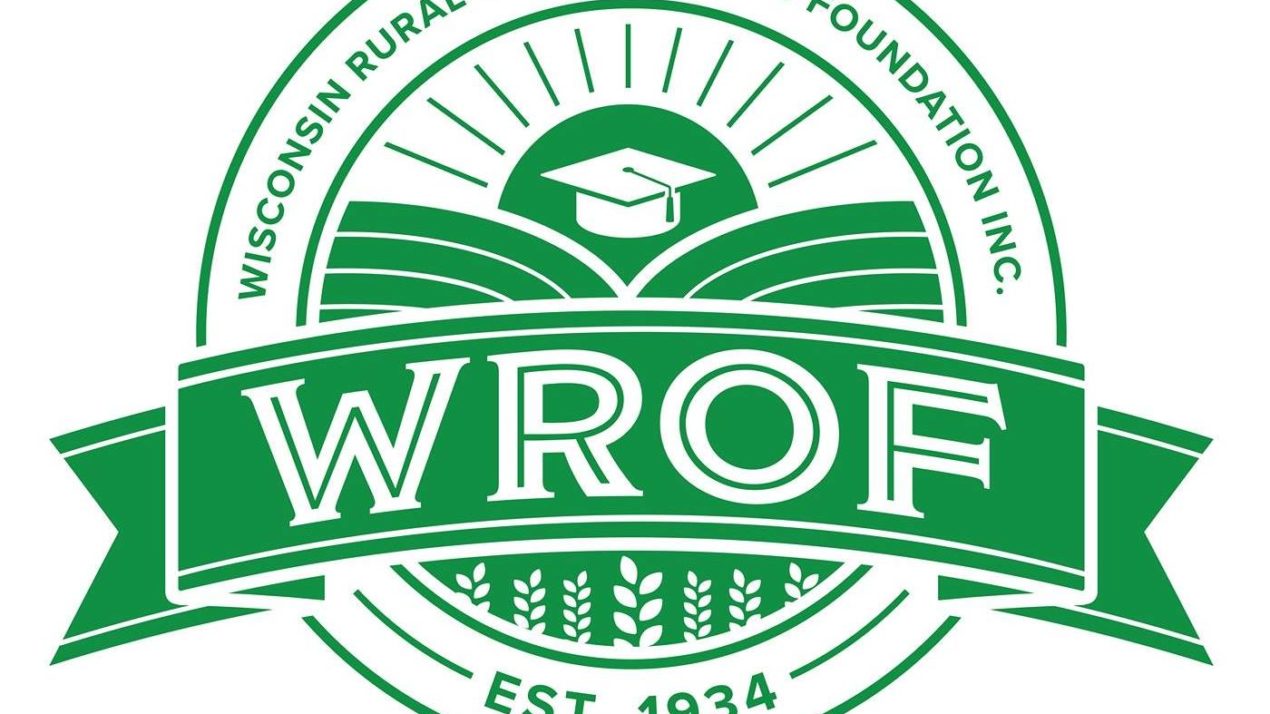
The Wisconsin Rural Opportunities Foundation (WORF) continues to be a valuable partner in outreach programs that help revitalize rural Wisconsin. This program is free to rural students and helps them explore the diversity of careers in science. Since its inception in 2007, the WROF has been supporting the program.
The workshop series brought more than 100 students and 15 teachers “face-to-face” to learn online from scientists at the Morgridge Institute for Research. The students and teachers logged on from 18 school districts in the Wisconsin Rural Schools Alliance and the Upward Bound program that focuses on underrepresented and first-generation pre-college students. Over six weeks, the students and teachers engaged with scientists working in the fields of metabolism, regenerative biology, medical engineering, medical imaging, and more.
“Through weekly Zoom calls, the students met with scientists, heard their personal stories, and began imagining their own paths into science,” says Dan Murphy, outreach and lab manager at the Morgridge Institute. During the workshop, students could select a morning or an afternoon lecture, and to Murphy’s surprise, many participated in both sessions. The students learned about the latest research at the Morgridge Institute, went on “behind-the-scenes” lab tours, and had Q&A time with the scientists.
“The opportunity opens up new possibilities for students and gives them the idea that UW-Madison is attainable for anyone,” wrote a participating rural high school teacher. “I am so thankful that this opportunity existed this summer for our students.”
Ross Soens, a graduate student in the Cantor Lab, said the summer workshop was a great way to work on his science communication skills, and to remember where he started as a budding scientist.
“I, too, was once a high school student in Wisconsin, and it was through the efforts of committed and enthusiastic teachers that I found myself on my current scientific career path,” Soens says.
Murphy says the workshop showed the Discovery Outreach team how an all-virtual experience can be a meaningful place to connect and inspire. The team is thinking about the next steps such as building in more virtual interactivity for next year. S
ince 1934, the Wisconsin Rural Opportunities Foundation, Inc. has invested in the education of people from rural Wisconsin so they, in turn, can transform and improve the economic health and quality of life in their rural areas. As a 501(c)(3) charitable foundation, more than 6000 individuals have received over $6.2 million in scholarships and grants in agricultural and rural health care education in over 30 different Wisconsin educational institutions and programs.
Rackow Family Sausage Issues Class I Recall for Summer Sausage Products

Rackow Family Sausage in Juda, WI, is issuing a voluntary Class I recall for five summer sausage products sold at its store. The recall includes the following:
- All Beef pepper cheese summer sausage with garlic and jalapenos, 0.9-lb. packages
- All Beef pepper cheese summer sausage with garlic, green olives and jalapenos, 0.9-lb. packages
- All Beef pepper cheese summer sausage with garlic, 0.9-lb. packages
- All Beef pepper cheese summer sausage with garlic, jalapenos and green olives, 0.9-lb. packages
- All Beef cheddar cheese summer sausage with garlic, 0.9-lb. packages
This is a Class I recall, initiated based on evidence collected during a routine inspection by state inspectors. Evidence shows that the products were produced without the benefit of inspection by state officials as required by law for meat products. More information on the U.S. Department of Agriculture recall classifications is available below and on USDA’s website at https://www.fsis.usda.gov.
No illnesses have been reported as a result of consuming these products. Anyone with signs or symptoms of a foodborne illness should contact their doctor. Consumers who have any of these products can return them to the original place of purchase or discard them. Consumers and media with questions about this recall can contact Jim Rackow, Rackow Family Sausage, at (608) 325-4547.
USDA Recall Classifications
| Class I | This is a health hazard situation where there is a reasonable probability that the use of the product will cause serious, adverse health consequences or death. |
| Class II | This is a health hazard situation where there is a remote probability of adverse health consequences from the use of the product. |
| Class III | This is a situation where the use of the product will not cause adverse health consequences. |
Dairy Industry Asks FDA Once Again to Enforce Labeling Rules

The following article is courtesy of the National Milk Producers Federation.
With FDA giving little indication of promised action on proper labeling of imitation dairy products, the National Milk Producers Federation today asked the agency’s ombudsman to ensure that rules are properly enforced.
“Allowing unlawfully labeled ‘plant-based’ imitation dairy foods to proliferate poses an immediate and growing risk to public health; it is a clear dereliction of the FDA’s duty to enforce federal law and agency regulations,” wrote NMPF President and CEO Jim Mulhern in the letter, sent to Dr. Laurie Lenkel, ombudsman for the U.S. Food and Drug Administration. “The FDA’s Office of the Ombudsman must intervene to break the bureaucratic logjam that is adversely affecting consumers. Doing so would fit squarely within the Office’s own mission to ensure even-handed application of FDA policy and procedures.”
The FDA ombudsman, based in the agency commissioner’s office, “serves as a neutral and independent resource for members of FDA-regulated industries when they experience problems with the regulatory process,” according to the agency. NMPF is urging the ombudsman’s office to take appropriate action to remedy the FDA’s lax approach to enforcing its own rules on the use of dairy terms on products containing no dairy ingredients, which have proven impacts on public health – a new phase of advocacy brought about by the agency’s regrettable inaction. The American Academy of Pediatrics and other organizations have offered evidence of nutritional deficiencies caused by confusion over the contents of plant-based versus dairy beverages.
NMPF last year released its own road map offering solutions to how public health, product integrity and free speech could be protected through updated regulations. NMPF also supports the DAIRY PRIDE Act, a potential legislative prod for FDA action, and has asked FDA commissioner Dr. Stephen Hahn to follow up on the pledge he made nearly one year ago to make fake-dairy labeling a high-priority issue at FDA.

